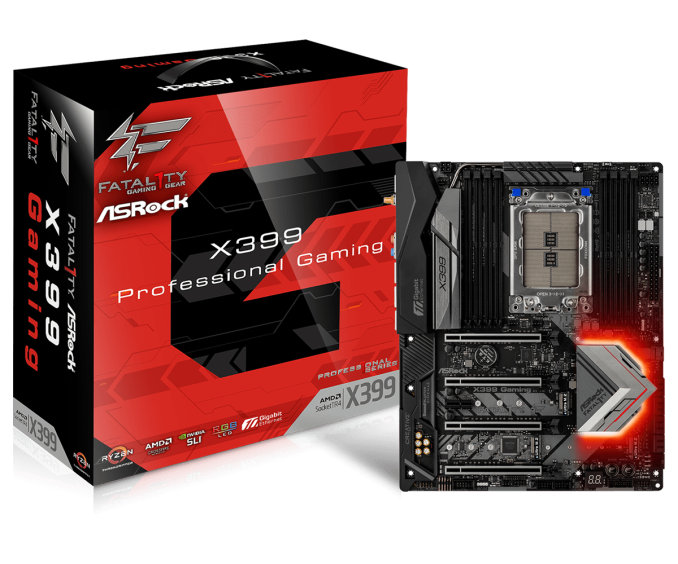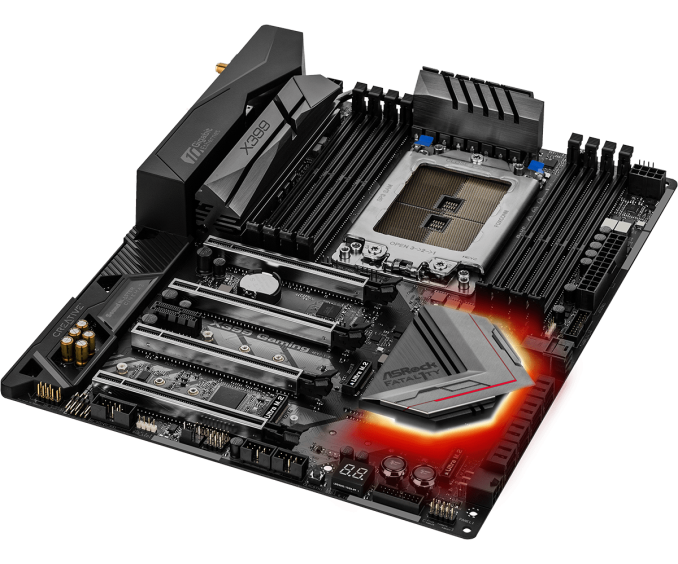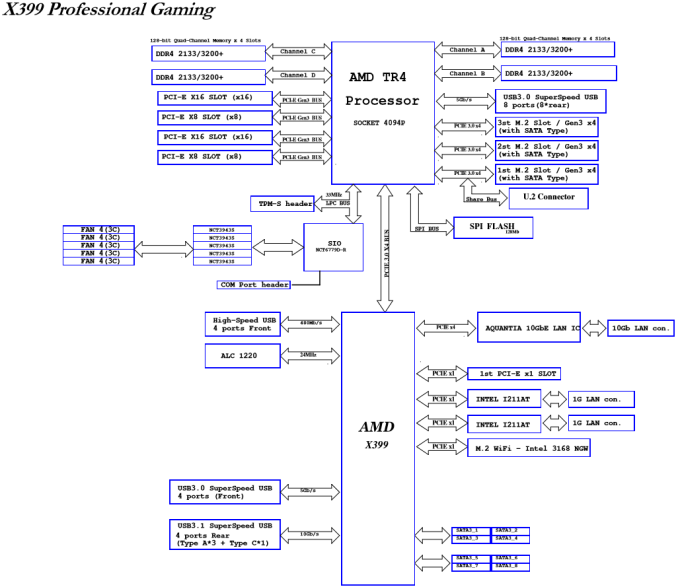An AMD Threadripper X399 Motherboard Overview: A Quick Look at Seven Products
by Ian Cutress & Joe Shields on September 15, 2017 9:00 AM ESTASRock
No stranger to the fray, ASRock is ready with the launch of two boards, the X399 Professional Gaming and X399 Taichi. Both boards share features but have enough differences to separate them in the product stack. The Pro Gaming adds 10 Gigabit Ethernet to its two Gigabit NICs and supports Creative Sound Blaster Cinema 3, while the Taichi aims to be a more mid-range board, by sticking with dual Gigabit NICs and uses Purity Sound 4. The styling is a little different too.
ASRock X399 Professional Gaming
The high-end board from ASRock will be the Professional Gaming. It also carries the Fatal1ty name, due to ASRock’s never-ending association with a pro-gamer from the turn of the century.
On the aesthetic side, the X399 Professional Gaming has a black PCB accented with gray heatsinks and grey stenciling where the M.2 slots are located. The memory slots are black, along with the rear IO cover that extends down the board. There are two heatsinks to cool the VRMs, connected by a heatpipe, and one reaches near to the rear IO. The chipset heatsink is not connected as part of the VRM cooling, but consumes a fairly large portion of the board and looks a bit like a play button. As with the fascination with RGB, the Professional Gaming has a few under the chipset heatsink. Users can add more RGB LEDs via two headers, and control them all through ASRock's RGB LED application.
The Professional Gaming has support for both NVIDIA 4-Way SLI and AMD 4-Way Crossfire with full-length PCIe slots. These have additional reinforcement to prevent sag or bending due to heavy PCIe cards during transit – the reinforcement is what ASRock calls its ‘Steel Armor’. The PCIe slots give an x16/x8/x16/x8 configuration from top to bottom, using 48 of the 60 PCIe lanes from the processor. The rest of the lanes are allocated to storage: there are a total of three M.2 PCIe 3.0 x4 slots, one of which is shared/switched with a U.2 connector. For other storage, there are eight SATA ports from the chipset that natively support RAID 0/1/10.
For added features, the X399 Professional Gaming jumps past the ever-present Gigabit Ethernet and uses an Aquantia AQC107 10 Gigabit LAN controller to appeal to users that want to invest in 10GbE. This is paired with two Intel I211AT network controllers, and all three can do regular gigabit Ethernet duties. If three Ethernet ports were not enough, also included is an integrated Intel AC8265 2x2 802.11a/b/g/n/ac WiFi module, to handle wireless duties.
ASRock provided chipset diagram for the Pro Gaming to show how it breaks down all the bandwidth:
For power delivery, ASRock uses a digital 11 phase International Rectifier solution, along with IR DrMOS for monitoring VRM current and temperature. Distributing power to the VRMs are two EPS 12V connectors, an 8-pin and a 4-pin, although the system will work with only the 8-pin installed. Typically we see EPS connectors oriented close to each other at the top of the motherboard, but here the connectors are located on opposite sides of the socket. As shown above, the 8-pin is in the upper right-hand corner above the DIMM slots, while the supplemental 4-pin is in the more familiar location at the top left-hand corner. ASRock asserts this creates a wider trace for the CPU VRM, bringing better power delivery efficiency and lowering temperatures.
For USB connectivity, the Professional Gaming has three USB 3.1 (10 Gbps) Type-A ports on the rear, one USB 3.1 (10 Gbps) Type-C port on the rear, two USB 3.1 (5 Gbps) headers for front panel ports, and two USB 2.0 headers for front panel ports.
| Fatal1ty X399 Professional Gaming | |
| Warranty Period | 3 Years |
| Product Page | Link |
| Price | $439.99 |
| Size | ATX |
| CPU Interface | TR4 |
| Chipset | AMD X399 |
| Memory Slots (DDR4) | Eight DDR4 Slots, up to 3600 MT/s Supporting 128GB Quad Channel |
| Network Connectivity | 1 x Aquantia AQC107 10 Gigabit LAN 2 x Intel I211AT GbE |
| Wireless Network | 802.11 ab/g/n/ac Dual-Band (2.4/5 GHz) Bluetooth 4.2 |
| Onboard Audio | Realtek ALC1220 |
| PCIe Slots | 4 x PCIe 3.0 (x16/x8/x16/x8) from CPU 2 x PCIe 2.0 x1 from Chipset |
| Onboard SATA | 8 x SATA 6 Gbps Supporting RAID 0/1/5/10 |
| Onboard SATA Express | None |
| Onboard M.2 | 3 x PCIe 3.0 x4 - NVMe or SATA |
| Onboard U.2 | 1 x PCIe 3.0 x4 (disables M2_1 when in use) |
| USB 3.1 | 1 x Type-A , 1 x Type-C (Rear Panel) |
| USB 3.0 | 8 x Rear Panel, 4 x via internal headers |
| USB 2.0 | 4 x via internal headers |
| Power Connectors | 1 x 24-pin ATX 1 x 8-pin CPU 1 x 4-pin CPU |
| Fan Headers | 1 x CPU 1A/12W Max. (4-pin) 1 x CPU Opt/Water Pump 1.5A/18W Max. (4-pin) 2 x Chassis (4-pin) 1 x Chassis Opt/Water Pump 1.(4-pin) |
| IO Panel | 2 x Antenna Ports 1 x PS/2 Mouse/Keyboard Port 1 x Optical SPDIF Out Port 1 x USB 3.1 Type-A Port (10 Gb/s) 1 x USB 3.1 Type-C Port (10 Gb/s) 8 x USB 3.0 Ports 4 x USB 3.0 Ports 3 x RJ-45 LAN Ports w/ LED 1 x BIOS Flashback Switch HD Audio Jacks |
















99 Comments
View All Comments
vgray35@hotmail.com - Saturday, September 16, 2017 - link
A few % better - you are looking at it wrong. Platinum PSU units with peak 94% efficiency means 6% heat dissipated. Now at 99% efficiency that is 1% dissipated as heat. That means a 5/6th reduction in heat or 83% less heat which is not just a few percent better. Further the new topology yields a >70% cost reduction which is also not insignificant. Gas turbines are also too noisy by the way, which is the main reason these are not considered (expensive when they go wrong too), and thus not a good comparison versus improvements being discussed here. Are you saying the linked article on PWM-resonance and resonance scaling topology is not worthwhile, or the problems with Buck converter inductors is not a severely limited and highly noisy power solution? Perhaps Power Electronics engineering is not your field of interest at all!Manch - Monday, September 18, 2017 - link
ICE is not 60% less efficient than a gas turbine. A gas turbine doesn't scale downward well. One of similar power would actually less efficient as an equivalent rated ICE. Gas turbines are impractical for vehicles.One benefit of a turbine would be no tailgating. The intake would suck in and crap out small critters all over your windshield.
vgray35@hotmail.com - Friday, September 15, 2017 - link
Yes I appreciate that - we draw power (Watts) at the rate of Joules of energy per second, Notice I said "we draw power", but that is also directly reflected proportionally as current in Amps (or a rate of Coulombs per sec), There was not a direct inference that power is measured in Amps, but only (a) "We are drawing a measure of power", and (b) this is approaching proportionally a resultant 150A. Yes I probably could have said better, but in wise did I say power is measured in AMPS.vgray35@hotmail.com - Friday, September 15, 2017 - link
I do not believe a defacto motto of the industry is "we are wasting 5% in heat, so let us not bother with wasting only 1%). Clearly you did not read the link to the Power Electronics article (I surmise), as then you would have realized the solution offers a huge reduction in cost as well as heat. The cost factor is something everybody is interesting in, even the industry at large, in my humble opinion.ddriver - Friday, September 15, 2017 - link
Huge? Like what? 6-7% better? Maybe 8-9%?What I meant is the solution you linked to is like 99% efficient, a good buck converter is what? Like 90-92%?
That's nowhere near the difference between an internal combustion engine and a gas turbine, the latter being more than twice more efficient. And still no adoption, even thou the solution is not really all that complex, and decades old. They still only use gas turbines in the most demanding applications, which is pretty much the same as with the converters from that article, which that dude developed for NASA's most demanding applications. I am pretty sure computers in NASA run on buck converters too, and they will use his designs only for the stuff they launch into space.
You probably don't realize how immense of an impact it would have if all cars on the planet become more than twice as efficient, burning more than twice as little fuel, outputting less than half the harmful emissions, traveling twice as far on a single fill. It would completely dwarf the benefits of boosting computer power converters from 90 to 99% :)
I am not saying it is not cool, I am just saying there have been a lot more beneficial a lot more high priority solutions that haven't been adopted yet for a lot longer, so you should not be surprised that the entire industry hasn't switched to a new power converter design overnight. They will do as they will always do, they will milk the cow until it dies, and then make it into jerky, and only then will then go for the new and better thing.
vgray35@hotmail.com - Saturday, September 16, 2017 - link
As noted earlier, 92% which is 8% heat versus 99% which is 1% heat means a 7/8th reduction in heat or 87% reduction. Thinking this is only a 7% improvement differential is incorrect - it is in this example an 87% improvement. That is not small potatoes. When this is coupled with a corresponding large cost reduction, then it becomes apparent the chip manufacturers would rather make more money using the older technology. Maybe the PSU engineers are just plain lazy or are not following the advances in their field as they are snowed under with work.Let's keep the discussion focused on power supplies.vgray35@hotmail.com - Saturday, September 16, 2017 - link
The 600W @ 12V fed to the motherboard with ~8% losses is ~50W heat in the VRMs (driving 180W CPU, 320W GPU, leaving 100W for other parts), The ATX power supply is 90% efficient or less with 60W heat also in the same case. The GPU power supply also is another 25W waste power supply heat, for a total of 135W of waste heat (as opposed to the useful heat generated within the various components themselves, which is heat generated from useful work being done). It is tough to manage this 660W in the case, but over 135W of it (>21% low ball estimate) is waste heat from just power supplies alone (ATX PSU, VRMs, GPU supply), of which over 80% or 110W could be eliminated by abandoning the Buck converter topology. This of course is a simplistic view, as there are other components too that are ignored here, for brevity's sake. I suspect >25% of heat comes from power supplies alone which can be dramatically curtailed. It's a 3 ringed circus: ATX PSU steals 10% for itself, motherboard steals another 8% for itself and GPU steals a further 8% for itself. We have no control over the power drawn from the mega chips themselves, but we do have control over the power supplies that drive them, and manufacturers could be doing a lot better here. And this is by no means a monster power hungry system with only one high-end graphics card. A >85% reduction in power supply waste heat can be realized if the Buck converter is abandoned, and that applies to resonant LLC power supplies also. The motherboard manufacturers and ATX PSU manufacturers need to take this aspect much more seriously.http://www.powerelectronics.com/power-management/s...
AMD's Thread Ripper X399 and Intel's X299 platforms should have been their first attempt at abandoning the Buck, half-bridge, and resonant LLC topologies. They failed us in that regard. We need this fiasco to come to an end by using hybrid PWM-resonant switching and resonance scaling, which eliminates the ferrite cored inductors altogether, and replaces them with just copper traces on the PCB. This is not rocket science.
Oxford Guy - Saturday, September 16, 2017 - link
Motherboard makers seem pretty much incompetent. They can't even be bothered to issue BIOS updates to fix serious bugs.ddriver - Sunday, September 17, 2017 - link
Yeah, but then again, an overclocked TR is like 200W, even an entry level car is like 200 KILOWATTS. So percentages are not really that much indicative.The facts remain. A TR mobo with a better power regulator circuit will save like 10 watts of power, a car with a gas turbine engine will save like 100 KW of power.
That's 10 000 times larger saving measured on absolute scales. What's more important in your opinion? Saving a watt, or saving 10 000 watts? Naturally, I'd rather have both. The goal here is to illustrate how low of a priority it is to improve mobo power delivery compared to some other, longer standing improvement opportunities that have been ignored.
Icehawk - Sunday, September 17, 2017 - link
They tried turbine cars, they are terrible due to the way they deliver power. Several successful drag cars have used them as in that application the power delivery works well. Same reason we aren't going to be driving rocket cars.